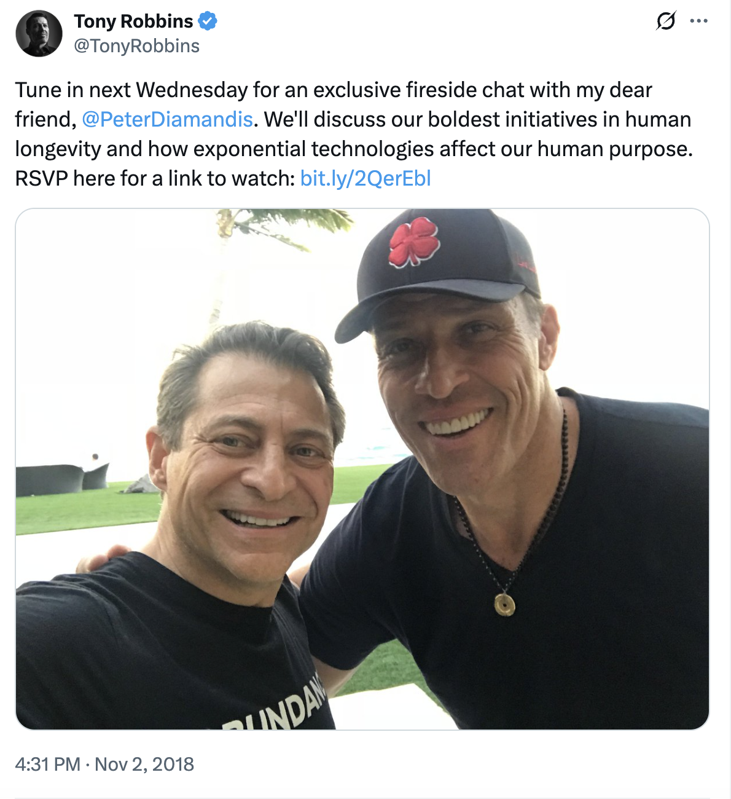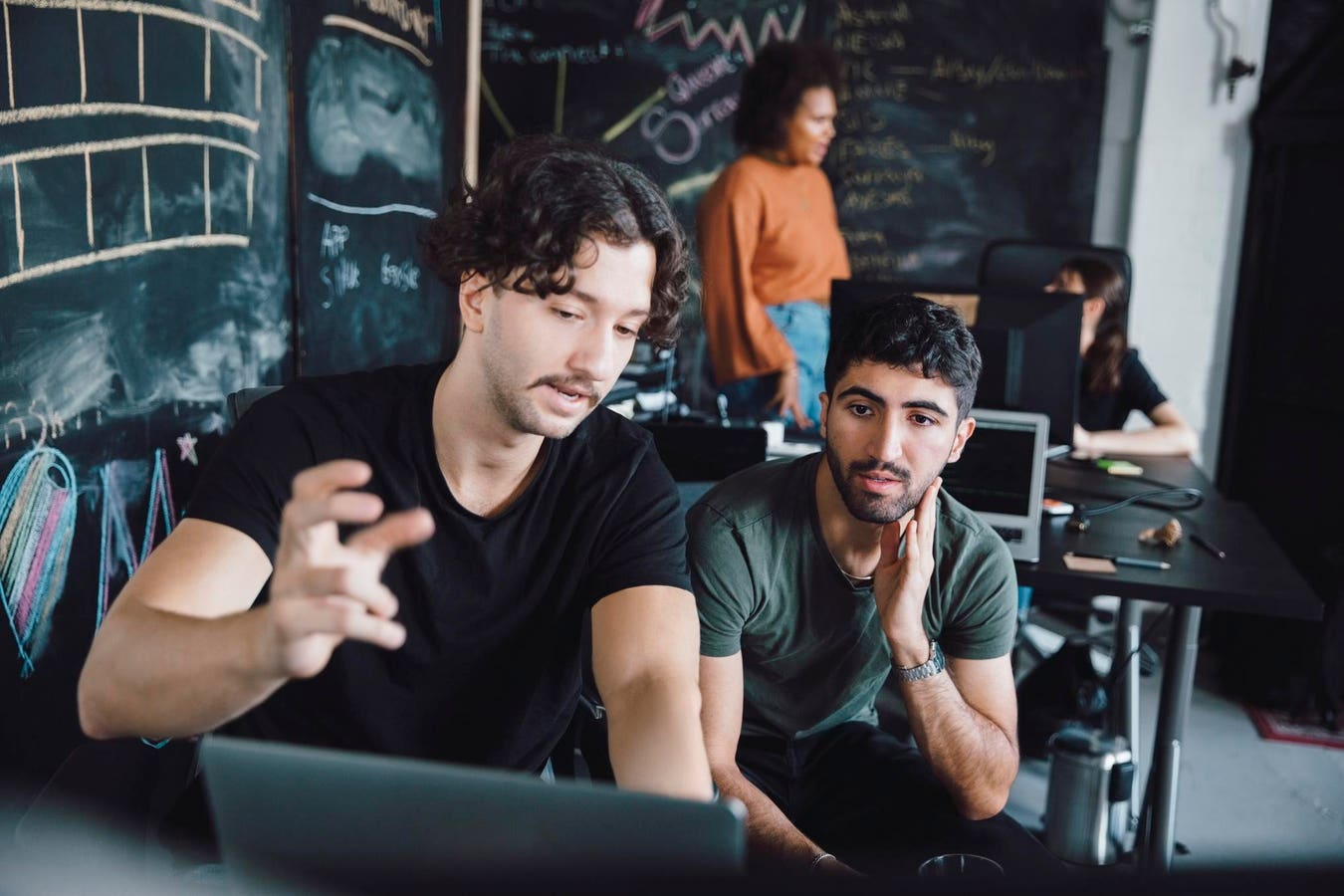Longevity investing isn’t dead—it’s evolving into a new era.
In my previous article on Ezra, Forward, Modern Age, and Ever/Body, I argued that the failures weren’t about consumer demand. The $5 trillion wellness economy proves appetite is there. The problem was capital: venture-backed models cracked under high CAC, weak retention, and shallow clinical depth.
Tony Robbins X post with Peter Diamondis
X
This week, the Wall Street Journal ran a story that reduced longevity to a roll call of billionaires chasing immortality. Jeff Bezos, Yuri Milner, Sam Altman—listed like celebrity donors at a gala. What it missed is the real story: sovereign wealth funds, dynastic family offices, and billionaires aren’t funding vanity projects. They’re seizing control of longevity from venture capital and turning it into a geopolitical and dynastic power play.
Capital at a Glance — Who Really Funds Longevity?
Capital at a Glance — Who Really Funds Longevity?
Forbes
As Sand Hill Road faltered, it revealed what insiders long suspected: venture capital is structurally ill-matched to fund the decades-long science of aging. Into that vacuum has stepped a new class of investor with deeper pockets, longer horizons, and far bigger ambitions.
For them, longevity isn’t just a market. It’s a weapon of statecraft, a lever of dynastic legacy, and the next great divide in global power. The question is no longer can startups sell us immortality in a box? It’s who will own the science of aging—and which nations and families will profit when we do?
When VC Lost Its Grip
Sand Hill Road hasn’t abandoned longevity—General Catalyst, a16z Bio + Health, and Khosla are still active. But results have lagged.
Venture can ignite early ideas, yet it falters in the long valley of biotech. Funds are built for 7–10 year returns; longevity science unfolds over decades. That mismatch has left a trail of stalled startups and stranded capital—forcing founders to seek out investors who can actually wait.
Why VC’s Track Record on Longevity Is Mixed
Longevity doesn’t fit the venture model.
- Time mismatch: Most VC funds run on 7–10 year cycles. Yet moonshot biotech—from cell reprogramming to biomarker diagnostics—can take 15–20 years.
- Consumer misfires: VC-backed “wellness-lite” startups ran into churn and credibility gaps. Ezra’s whole-body scans, Ever/Body’s boutique medspas, and Forward’s futuristic clinics all struggled to retain customers long enough to justify the spend.
- Exit drought: Biotech IPOs peaked at 104 in 2021, then collapsed to 24 in 2022. By Q2 2025, there were zero biotech IPOs—the worst drought in 15 years (BioPharma Dive; William Blair). With exits frozen, VCs hesitate.
The Rise of Long-Horizon Capital
Where VCs stumbled, others seized control. Billionaires, dynasties, sovereign wealth funds, and hybrid foundations are repositioning longevity as more than a financial asset class. They frame it as legacy, national insurance, and intergenerational continuity.
“Family offices are no longer sidelines, they are at the center of longevity’s capital story,” says Abbas Hashmi, Principal at Saudi Family Holdings. “UBS finds they now allocate 44% of their portfolios globally to alternatives, and 54% in the U.S. Within these allocations, healthcare and life sciences consistently rank among the top private equity targets, showing real long-horizon commitment to human wellness.”
Abbas Hashmi doing a keynote at the 24Fintech Conference in Riyadh
Abbas Hashmi
The New Builders of Longevity
Billionaires: Beyond Vanity Projects
According to WSJ, the ultrawealthy have committed more than $5 billion over the past 2½ decades into longevity ventures. Bezos and Milner funneled over $3 billion into Altos Labs; Altman pledged $1 billion to Retro Biosciences; Peter Diamandis and Tony Robbins raised $18 million for Fountain Life; Dave Asprey is privately backing Upgrade Labs.
But these aren’t quarterly-return bets. They are legacy projects—and they’ve opened the door for dynasties and sovereign funds with even broader ambitions.
Family Offices: Dynasties Move Center Stage
Family offices have quietly become the most important class of longevity backers. They control an estimated $10 trillion in global assets and allocate heavily to healthcare and life sciences—34% of portfolios on average, according to Goldman Sachs. UBS reports U.S. family offices put 54% of their portfolios into alternatives, with healthcare consistently among the top targets.
From Adidas heirs investing through leAD Sports & Health Tech Partners in Riyadh, to India’s Claypond Capital (Ranjan Pai) seeding Biopeak with $3 million, dynastic families see longevity not as IRR, but as intergenerational insurance. As Abbas Hashmi of Saudi Family Holdings notes: “For family dynasties, investing in longevity is not about IRR. It is about ensuring their grandchildren inherit both wealth and health.”
Sovereign Wealth Funds: Longevity as National Strategy
Sovereign wealth funds have even deeper pockets. Collectively they manage $11.2 trillion globally (IFSWF). The Abu Dhabi Investment Authority alone controls about $1.06 trillion, while the Qatar Investment Authority manages $557 billion. Though not all longevity-specific, healthcare and biotech are already priority allocations—and insiders expect dedicated longevity vehicles to emerge.
“Middle Eastern and Asian sovereign wealth funds view longevity as a diversification play, moving national portfolios beyond hydrocarbons and infrastructure,” Hashmi explains. “Healthier citizens mean lower healthcare costs, higher productivity, and stronger demographic dividends.”
In this framing, longevity is not just capital allocation—it’s a lever of statecraft, embedded into culture, demography, and national brand.
Saudi Arabia’s PIF, Abu Dhabi’s Mubadala, Qatar’s QIA, Malaysia’s Khazanah, and Singapore’s Temasek are already visible in healthcare. While PIF hasn’t launched a dedicated longevity vehicle yet, insiders expect one soon.
Beyond capital, longevity is being embedded into culture. Adam Neumann’s Flow is experimenting with wellness-centric residential communities in Riyadh. As Hashmi frames it: “For sovereign investors, longevity is not only capital allocation, it is a statement of leadership, positioning their countries at the forefront of science, diplomacy, and generational legacy.”
Hybrid & Mission-Driven Funds
- Methuselah Foundation / SENS: incubating Oisin, Turn Bio, Repair Bio.
- Clinique La Prairie Longevity Fund: €100M targeting near-market solutions.
The WeWork billionaire has exported his new co-living startup Flow to Saudi Arabia.
Getty Images for WeWork
Why This “Longevity” Capital Is Different
Why this capital Is different chart
Forbes
These investors don’t measure success in quarterly IRR but in decades of legacy, influence, and demographic resilience. As Hashmi puts it, “Middle Eastern and Asian sovereign investors see what Silicon Valley missed. Longevity is not a venture sprint; it is a generational marathon.” That philosophy is shaping not only who funds longevity, but where—and why.
A New Global Map of Longevity
- Silicon Valley: Altos, Retro (biotech moonshots).
- Europe: Clinique La Prairie (luxury clinics + funds).
- India: Biopeak (family office + VC hybrid capital).
- Middle East: sovereign wealth–backed wellness ecosystems, from clinics to real estate.
- Asia: Temasek (Singapore) and Khazanah (Malaysia) leading health allocations. China has committed $9B+ to its National Stem Cell Program, making regenerative medicine a pillar of state science. Japan’s “Society 5.0” plan integrates longevity biotech into its aging strategy, while South Korea’s Samsung Biologics and Cha Biomedical are pushing anti-aging exports.
This isn’t just geography—it’s ideology. In California, longevity is a tech revolution. In Riyadh or Zurich, it’s a matter of national brand and dynastic power. In Singapore, Beijing, and Tokyo, it’s economic diversification and survival.
Demographics As Destiny
Longevity is not just science—it’s math. Nations are facing demographic cliffs that make investment in healthspan a political and economic necessity.
- Japan: median age 49; healthcare spending projected to hit 12% of GDP by 2040.
- Europe: one in four citizens will be over 65 by 2050 (Eurostat).
- China: working-age population shrinking since 2012; healthcare spending projected to double by 2035.
- Saudi Arabia: median age 29, but investing in longevity to diversify beyond oil.
- United States: by 2034, seniors will outnumber children for the first time (U.S. Census Bureau).
Demographics Snapshot: Why Nations Care About Longevity
Japan’s aging costs, Europe’s silver wave, China’s shrinking workforce, America’s senior tipping point, and Saudi Arabia’s youth bulge all explain why longevity has moved from science experiment to state strategy.
Implications For The $5 Trillion Wellness Market
The wellness economy has surpassed $5 trillion, but the definition of success is shifting. The next generation of longevity ventures won’t be built on supplement subscriptions or boutique scan clinics. They’ll be platforms that marry decades-long R&D with consumer-facing adoption—and they’ll be backed by capital that can wait.
Conclusion
Longevity isn’t a billionaire hobby, despite how WSJ framed it. It’s the re-engineering of an industry away from fast-money venture capital toward long-horizon, strategic capital—driven by legacy and statecraft, and willing to play out over decades rather than fund cycles. And that shift could define not just who lives longer—but which nations maintain political stability, which families hold dynastic wealth, and which regions control the science of aging. Longevity is no longer just a market—it’s a new axis of global power.
For more on how shifting capital is reshaping longevity, health and biotech, read my analysis of AI, private equity, and radiology’s reckoning.
The Real Capital Story
The Real Capital Story
The Real Capital Story
Market Snapshot: Longevity’s New Capital
Forbes









